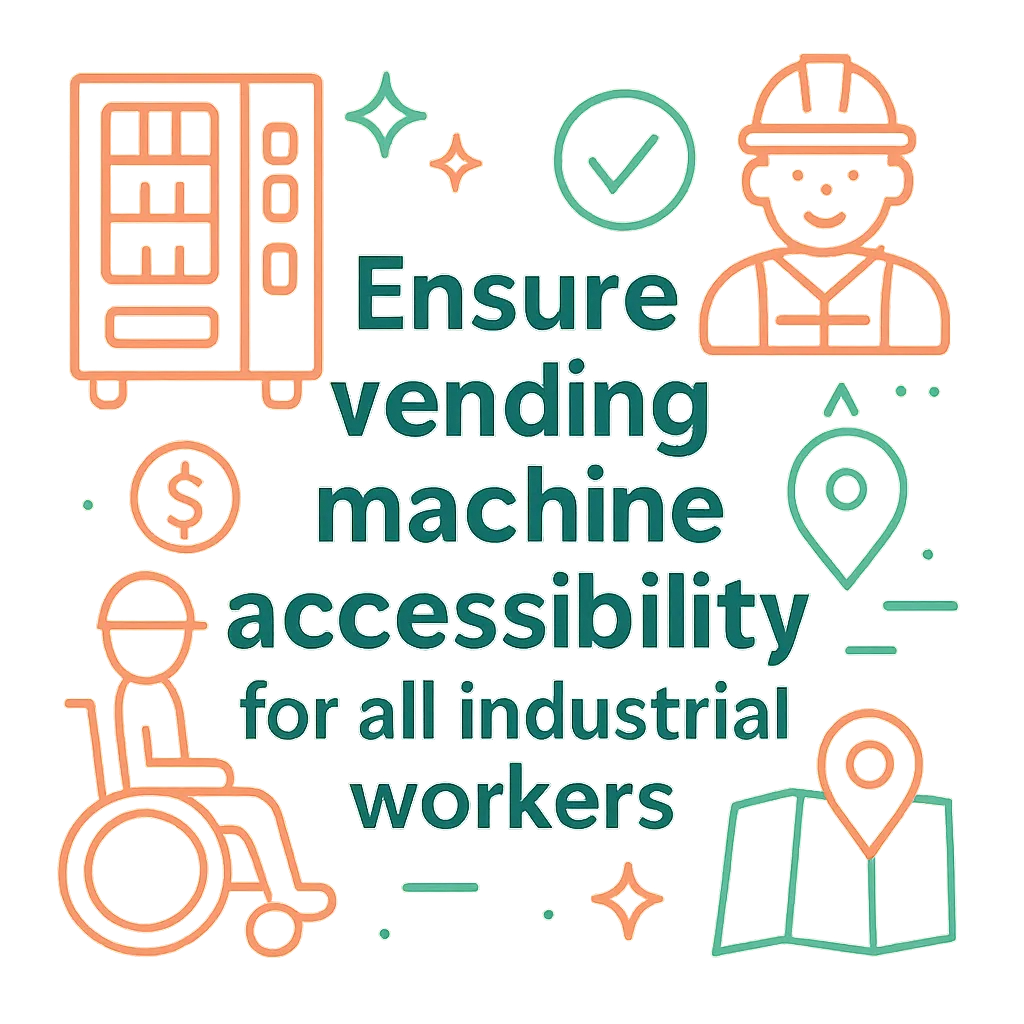Vending Machine Accessibility for All Workers
Ensure vending machine accessibility for all industrial workers. Explore ADA compliance, inclusive design, and placement best practices for diverse teams.
Back to Vending for Warehouses ResourcesEnsure vending machine accessibility for all industrial workers. Explore ADA compliance, inclusive design, and placement best practices for diverse teams.
Back to Vending for Warehouses ResourcesAccessible vending machines are not just about compliance; they're about creating an equitable environment where every team member can comfortably access refreshments.
![]() ADA-compliant machines ensure equal access for all abilities
ADA-compliant machines ensure equal access for all abilities
![]() Inclusive design enhances employee satisfaction and morale
Inclusive design enhances employee satisfaction and morale
![]() Strategic placement guarantees easy navigation and use by diverse teams
Strategic placement guarantees easy navigation and use by diverse teams

In today's industrial workplaces, fostering an inclusive environment for all employees is paramount. This extends to every aspect of the facility, including the convenience of accessing refreshments. Vending machine accessibility for all workers is not merely a regulatory requirement but a fundamental part of designing a supportive and equitable work setting. By focusing on ADA compliance, thoughtful machine selection, and strategic placement, businesses can ensure that every employee, regardless of physical ability, can enjoy snacks and beverages with ease.
The Americans with Disabilities Act (ADA) sets specific guidelines to ensure public accommodations are accessible to individuals with disabilities. For vending machines, this means considering factors like maximum and minimum reach ranges, operating mechanism requirements, and clear floor space. In industrial environments, where workers may navigate with varying mobility aids or in different physical conditions, adhering to these standards is critical. This ensures that controls are within reach, payment systems are easy to operate, and pathways to machines are unobstructed. Implementing these considerations leads to happier, more productive workers and a more positive workplace culture.
Modern vending technology offers various features that enhance accessibility. Look for machines with lower coin slots, accessible keypads, and touchless payment options. The physical placement within the facility is equally vital. Vending machines should be located on accessible routes, with sufficient clear floor space for a wheelchair to approach and maneuver. Consider high-traffic areas like breakrooms or near time clocks, ensuring these spots also provide ample space. For insights into suitable equipment for industrial environments, you might review options like best vending machines for industrial facilities. Careful planning here minimizes potential barriers and maximizes convenience.
While ADA compliance is a legal necessity, the benefits of accessible vending extend far beyond avoiding penalties. An inclusive approach to vending machine access demonstrates a strong commitment to employee well-being and diversity. It empowers all workers to take breaks and refuel independently, promoting a sense of belonging and value. This can lead to increased morale, reduced stress, and ultimately, enhanced productivity across your diverse workforce. For facilities operating round-the-clock, ensuring 24/7 accessibility is also key, as discussed in 24/7 vending solutions for shift workers. Investing in accessible vending is an investment in your people and the overall success of your operation.
ADA compliance ensures vending machines are accessible to people with disabilities, including specific height, reach, and operability requirements.
It ensures that all workers, regardless of physical ability, have equal access to refreshments, promoting inclusivity and productivity.
Features include lower coin slots and keypads, wider pathways, and easily operable controls that don't require tight grasping or twisting.
Proper placement ensures clear, wide paths for wheelchairs, adequate maneuvering space, and proximity to accessible routes.
While many new machines are designed with accessibility in mind, it's crucial to verify compliance with specific ADA guidelines, particularly for older models or unique site requirements.
Cashless payment options like card readers and mobile pay are generally more accessible as they eliminate the need for fine motor skills required for coins.
Yes, features like touchless selection via apps, voice prompts, and remote control capabilities can significantly enhance accessibility for various disabilities.
Both the business hosting the machine and the vending service provider share responsibility for ensuring the machines and their placement meet accessibility standards.
It fosters a more inclusive work environment, boosts employee morale, and reflects a company's commitment to diversity and worker well-being, potentially increasing usage by all workers.
The Americans with Disabilities Act (ADA) Standards for Accessible Design provide detailed specifications for vending machine accessibility.